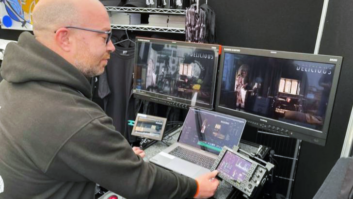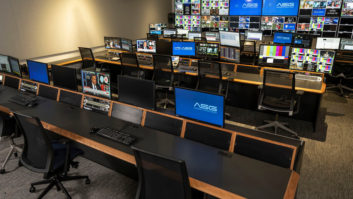
Broadcasters are awash in a sea of assets, some essential for creation of content, some with real potential for monetisation, and some with no known use…yet. But without proper management, the asset sea easily becomes a swamp. In the first of our two Forums this month, Philip Stevens leads an investigation into MAM systems.
File based workflows are widespread throughout the industry, and there continues to be an abundance of providers of MAM systems to organise that data. But do users get the most from such systems? Are mini-MAMs viable? What questions should a potential customer ask to ensure the right package is purchased?
We convened a new Forum to explore the issues in further detail. Participating (in alphabetical order) are Warren Arenstein, SVP Business Development at Primestream Corporation; Brian Campanotti, chief technology officer, Front Porch Digital; Ed Casaccia, Grass Valley’s senior director, Solutions Marketing; Raoul Cospen, Dalet’s director of Marketing and Business Development; Craig Dwyer, senior director, Global Centre of Excellence, Avid; Petter Ole Jakobsen, chief technical officer, VizRT; Karl Mehring, senior product manager, Snell; Pavel Potuzak, managing director, Aveco; Patrice Rosay, Netia Solution architect and bid manager; Mike Shaw, managing director, IBIS MAM, Orad Hi Tec Systems and Julian Wright, co-founder and general manager, Blue Lucy Media.
TVBEurope: How does a MAM help improve quality of broadcast output?
Arenstein: (Pictured) It helps in so many ways throughout a production workflow that it is not easily quantifiable. But to put it in its most basic terms, having access to content and relevant descriptive metadata allows producers to make more informed choices and tell better stories. All users benefit from being able to find the right shot at the right time.
Campanotti: The ability to access, browse, and query file-based archives easily via a simple, unified desktop interface enhances the overall creative process. It does this by minimising the complexities of underlying formats and high-resolution file storage locations, and provides a multitude of ways to search and locate content easily. Most MAM systems allow direct desktop shot list creation, and some facilitate simple, frame-accurate cut editing by leveraging the functionality of the backend content storage management or archive solution. With this desktop access, creative staff can better manage, easily repurpose, and truly drive the nonlinear creation process.
Casaccia: A MAM system, considered separately from actual production tools, can certainly contribute to the quality of broadcast output since it is the means by which the best and most compelling audio and video involved in the production can be ascertained and accessed.
Cospen: With direct access to content from production and archives, users can easily and quickly find entire media spaces and archives, selecting the most compelling material. And because it is easier and faster for users to locate the best possible material, the organisation as a whole has more time to assemble a higher quality finished package for air.
Dwyer: MAM can improve broadcast output in many ways. For example, having a consistent way to describe assets makes them easier to find, and leads to greater reuse opportunities which, in turn, can release budgets for new material. A MAM system can reduce or remove many manual tasks often eliminating time consuming and repetitive housekeeping activities. This improves a media organisation’s operational efficiencies by freeing up staff to concentrate on creating more valuable and inspiring creative content.
Jakobsen: (Pictured) In general, file-based workflows also make it easier to introduce new tools or codecs – which allows more aggressive use of the latest technology. Quality comes from consistency – and here a MAM allows implementing fine-grained control into the production process to improve consistency and thereby quality.
Mehring: MAM has the ability to improve both quality and variety of broadcast output by ensuring that potentially complex workflows can be automated in an elegant and repeatable manner, minimising the chance for errors introduced by otherwise manual processes.
Rosay: If a MAM is to improve the quality of the broadcast output, it must be at the heart of the information system. Deployed as a central part of the broadcast system, the MAM solution serves as a backbone that enables greater efficiency in producing content. Offering a straightforward and ergonomic GUI, the MAM system simplifies the tracking, management, and optimisation of content life cycles, enabling greater productivity and delivery of a better end product.
TVBEurope: What efficiency savings are possible through the use of a MAM?
Arenstein: Efficiencies are immediately found when content is ingested and/or digitised once – then made available to all users everywhere for immediate editing and distribution, instead of making multiple copies of material. Tape should no longer be a major operational cost. Efficiencies can be increased by adding an automation engine to the MAM, like automatic input of descriptive metadata – or conditional actions based on metadata entry.
Cospen: (Pictured) MAM offers efficiencies across the entire workflow, but there are a few key capabilities that stand out with regards to efficiency. The ‘while’ scenario – example, the ability to edit while recording – is a must for fast-paced productions. Asset-centric production is another.
Jakobsen: The main efficiency saving is via simpler tools. This means more staff can do more types of jobs. A typical example is getting producers and journalists to do more rough cutting or pre-editing themselves. With simple tools from your desktop, you don’t need to reserve a specialised seat and you don’t have to run back and forth in your facility as much.
Potuzak: A tapeless environment eliminates the cost of physical storage of tape, cost of tape itself, cost of erasing and recycling tapes, etc. A MAM usually includes a workflow manager to automate many day to day activities such as transcoding a file into multiple formats and distributing content. This can all be automated with a checkbox rather than manually by one or more people.
TVBEurope: Is a MAM system an ‘off-the-shelf’ purchase or a tailor-made solution?
Arenstein: It’s important that a MAM be built to evolve with the workflow demands in news, sports and entertainment. Each installation has needs that are very specific and, in the most part, unique. An off-the-shelf purchase will not serve the needs of these customers. A quality MAM solution is tailored to the specific needs of an installation in order to provide users with tools that are specific to the production workflow – yet ready to grow as needed.
Casaccia: It is both. In general, the long-term support outlook for a fully productised off-the-shelf is far more secure than a bespoke project MAM. However, the off-the-shelf product must offer sufficient flexibility and configurability so that it can be matched to the individual customer’s needs.
Cospen: MAM projects are becoming less and less tailor-made. We often come across existing integrations. Our BPM workflow engine makes it possible to work with these existing integrations – configure workflows and gain agility. We are even taking this concept of off-the-shelf a step further by offering a packaged MAM solution which is very similar to our solutions for News and Sports.
Dwyer: At Avid we have come to the conclusion that the market wants both models. We offer an off-the-shelf solution called Avid Interplay MAM ‘foundation’, which covers everything required to get up and running. It includes the fully functional system, import and archive workflows, and third party systems. It also includes installation, training and one year of support. Additionally we offer a tailor-made approach for clients who have more complex requirements and want the flexibility of building specific integration, workflow or using a custom data model.
Mehring: (Pictured) A MAM system should be an off-the-shelf purchase which allows users to modify metadata schemas and workflows without the need to contact the manufacturer. All the flexibility should be inherent in the product, as should various interface standards such as BXF, WSDL APIs and even simple drop folders to allow interoperability with many and various other business systems.
Potuzak: Aveco offers an off-the-shelf product that is customised to the customer’s requirements. Any software that is custom built these days should raise big red flags for management – they usually end up being expensive disasters and very difficult to update and maintain. Aveco’s approach is to offer a flexible database product where metadata can be easily made specific to the customer’s workflow and a workflow engine that can be programmed to automate day-to-day activities without making it ‘custom’. Upgrades to the system are easy as the ‘custom’ aspect of the product is in config files and not the core software itself.
Rosay: (Pictured) A MAM system must integrate smoothly into a wide ecosystem and address different business processes — marketing, production, archives, post production — within the broadcast environment. While all of these areas share concepts in common, most of them must deal with specific processes and their own workflow. Therefore, a MAM system must be open, scalable, and flexible enough to interface with any third-party system and to accommodate a broad spectrum of activities. The best solution would be one that reduces implementation cost and simplifies installation procedures with a system that can easily integrate, adapt, and fit in with the existing broadcast environment and business processes. The Netia MAM offers a system that is compatible with most existing broadcast models and that also provides simple tools for creating and personalising the interface according to users’ specific workflow requirements.
Shaw: Historically, MAM has a reputation for resulting in an expensive, long-running, custom project. Orad iFind, however, is modular and scales from small specific workflows to multi-site enterprise-level implementations. In particular, broadcast workflows can be handled using the standard iFind product with customer specific configuration. This puts the customer in control of the evolution of the system and reduces costs.
Wright: (Pictured) There is now a broad view amongst broadcasters, production companies and content owners that there is no such thing as a one-size-fits-all MAM. Off-the-shelf offerings which are positioned as ‘highly configurable’ are never quite configurable enough to suit all operational needs.
TVBEurope: Does a MAM need to cover all file based activities, or is it viable to have a mini MAM for selected functions?
Casaccia: It is highly unlikely that any one MAM system will provide the ideal solution for every given use. An example of this might be sports logging which is generally accomplished using highly specialised software tools—this could be considered a mini-MAM in the sense of this question.
Dwyer: It’s totally feasible to have a ‘mini MAM’ for some clients who are just entering this new workflow – starting small and focused can help educate the organisation on the language, and challenges faced when implementing a MAM system. In fact, we often see multiple ‘mini-MAM’ disconnected from each other with impact on efficiency and throughput. One of the major business benefits of adding a MAM is bringing together multiple content repositories, different departments and manual activity to enable a more efficient overall operation.
Jakobsen: The mini-MAM is quite useful. There are some aspects of production that need an end-to-end cover from a MAM system, like programme delivery and there are others where a more ‘island’ approach or mini-MAM, like for playout. The Viz Media Engine Clip Store is an example of a mini-MAM that manages clips for tools like Viz Content Pilot and Viz Trio.
Mehring: To realise their full potential, MAM systems must cover all file-based activities. Synchronisation between multiple mini MAM systems can cause headaches as some may not be as flexible or extensible as others. A MAM should not be focussed on tasks relating to a vendor’s own equipment in isolation.
Potuzak: (Pictured) To best leverage the advantages of a MAM it should cover all activities – but it is not absolutely necessary. For example, one could implement a MAM in news, but not master control. Also, a low risk way for a customer to get into file-based workflows with a MAM is to incrementally convert specific functions over time rather than do the whole facility at once. Maybe start with ingest for news, but keep the current workflow as is until that task works as expected, and then move on. This gives people time to adjust to a new way of working without major risk to the whole operation.
Shaw: MAM should be modular and scalable and deployable both for specific tasks or complete workflows. A key part of an iFind implementation is the interfacing to other business systems and processes, allowing it to be an integrated part of an operation whatever the scale.
Wright: MAM is demanding careful consideration as an operational or business strategy rather than as a product from a vendor. Trying to implement a single MAM to cover all broadcaster activities from acquisition to delivery is a likely to be a protracted and expensive task, with a poor cost/benefit return. A MAM strategy should complement the needs of the business operation and bring otherwise disparate processing and management systems together.
TVBEurope: What questions should a potential customer ask of a MAM supplier to ensure the right package is purchased?
Arenstein: Inquire about flexibility, scalability, configurability and be clear with the expected deliverable. I feel it is more important for the vendor – who has proven experience and knowledge of the product – to ask the potential customer the right questions. This leaves it up to the vendor to comprehend the workflow and design a solution that works best for the customer.
Campanotti: It is important to focus on key objectives and lay out a pragmatic and staged implementation plan. This approach will lead to a much more cost-effective solution and allow time for the customer to think more carefully about the inner workings of the facilities and staff. It also allows a more agile reaction to workflow changes, technical challenges, and human factors.
Cospen: MAM is a vast subject. There are many possible workflows, many possible formats, integrations with third-party systems, and so on. We advise our customers to have a top-down approach of their requirements. First, think about the business objectives, and what the future needs will be, before getting into the workflow details, then the technical requirements. A lot of those questions are usually answered during the pre-sales phase, along with system architects and workflow consultants.
Mehring: How flexible and extensible is the product out of the box? What level of statistical reporting is available? How easy is it to visualise and modify file based workflows by the user?
Shaw: (Pictured) Potential customers need to make it clear what they want to achieve and then look for the supplier to detail how the proposed solution would work in their specific environment. Focus on workflows first, technology second – it is the user that will ultimately be the judge!
Wright: The stock answer of having ‘a well document API’ isn’t enough. Customers should satisfy themselves that any interfaces do indeed give them the access to required data or functions and the vendor is willing, at accepted rates, to carry out integration works.
TVBEurope: Can a MAM add revenue streams to a user’s portfolio?
Campanotti: Leveraging MAM and a digital asset repository will allow the creative process to focus on creativity rather than technical challenges, format compatibility, migration, etc. This more intense focus on creativity can allow new avenues for revenue generation to evolve more quickly. Further, allowing the ‘testing’ of these new revenue opportunities without having to make a large investment in infrastructure or staff can make the organisation more agile and better able to start and stop these initiatives based on results.
Casaccia: (Pictured) Unfortunately, the answer to this question is probably no, at least not in the direct fashion. A MAM system must generally be considered a ‘cost of doing business’ – similar to inventory management in any other industry. Differentiation among the valuation of MAM systems is found in how they minimise this cost. Finding new revenue streams such as web or video-on-demand simply allows this cost to be recouped more thoroughly.
Cospen: Typically, our customers leverage the productivity gains from MAM to launch new distribution or broadcast channels, which can have a direct – and positive – impact on revenue. For instance, Mediaset in Italy is able to distribute 10 times more content with the Dalet MAM and hence, more revenue stream opportunities.
Jakobsen: The most common approach is that you add more channels. With a file-based workflow or MAM adding channels is easier and less expensive. The other approach is to sell in-house media for which you have rights to other businesses. The MAM lets you exploit business opportunities much more quickly and efficiently. As the saying goes, ‘luck is when opportunity meets preparation.’
Potuzak: Yes. Revenues come from a business model of reusing their most important asset – their content. If you can’t find it, you can’t use it and you cannot sell it. That is the problem with manual tape-based systems, finding the right content quickly. It also enables customers to mark their content so if they sell it for rebroadcast by others, they can verify if it is legal.
Rosay: The automated handling and distribution of content allows MAM system users to process media in less time and to complete a higher volume of processing tasks in that time. A MAM system enables users to optimise ROI, not only by monitoring production costs, but also by enhancing the quality of the content being produced.
Wright: Certainly. A content owner who has an asset catalogue that is well indexed and readily retrievable is able to rapidly and inexpensively exploit new business models as they develop. We see the MAM and properly catalogued material as core to monetising content archives.
TVBEurope: What steps are needed to ensure Metadata is preserved accurately throughout the media management process?
Campanotti: (Pictured) Metadata accuracy through the entire content lifecycle is key to any enterprise MAM system. Enrichment of technical metadata during capture, migration, and ingest should be married with programme and contextual metadata as it flows through the production, transmission, and online chains. Each consumption mechanism will have its own specific requirements. It is also imperative that the MAM be able to map, translate, extract, and publish metadata from the growing repository over time in order to feed these consumption and monetisation paths accurately.
Casaccia: Since the structure of metadata that is associated with incoming content, as well as that which must be associated with content being placed in multiple delivery
www.bluelucymedia.com
www.fpdigital.com
www.grassvalley.com
www.dalet.com
www.vizrt.com
www.snellgroup.com
www.aveco.com
www.orad.tv
www.netia.pl







